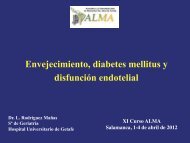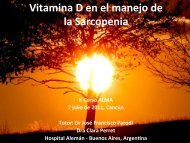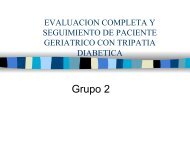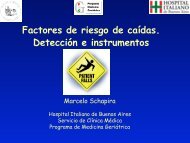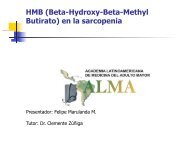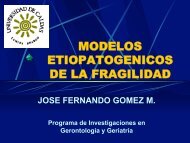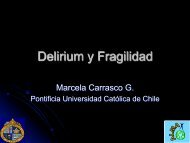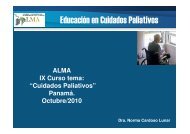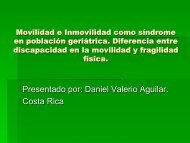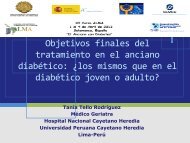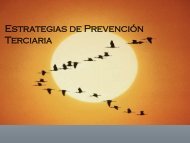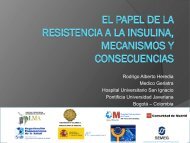Tratamiento hormonal de la Sarcopenia. Fracnsico Javier López ...
Tratamiento hormonal de la Sarcopenia. Fracnsico Javier López ...
Tratamiento hormonal de la Sarcopenia. Fracnsico Javier López ...
You also want an ePaper? Increase the reach of your titles
YUMPU automatically turns print PDFs into web optimized ePapers that Google loves.
TRATAMIENTO HORMONAL DE LA<br />
SARCOPENIA<br />
FRANCISCO JAVIER LÓPEZ ESQUEDA<br />
UNIVERSIDAD AUTÓNOMA DE SAN LUIS POTOSÍ<br />
MEXICO
OBJETIVOS <br />
v Analizar los resultados <strong>de</strong> los principales<br />
tratamientos <strong>hormonal</strong>es como una forma <strong>de</strong><br />
intervención para disminuir el grado y efectos<br />
<strong>de</strong> <strong>la</strong> sarcopenia en adultos mayores<br />
v Determinar <strong>la</strong> utilidad o futilidad <strong>de</strong> su uso
PRINCIPALES HORMONAS UTILIZADAS EN EL <br />
TRATAMIENTO DE LA SARCOPENIA <br />
v GH <br />
v DHEA <br />
v TESTOSTERONA <br />
v ESTROGENOS <br />
v OTROS TRATAMIENTOS POTENCIALES
HORMONA DE CRECIMIENTO GH <br />
DISMINUCIÓN FISIOLÓGICA DE LA SECRECIÓN DE GH CON LA <br />
EDAD <br />
“somatopausia” <br />
www.unidadan)envejecimiento*.es
LAS INTERVENCIÓNES CON GH INCREMENTAN <br />
LA MASA Y FUERZA MUSCULAR EN EL ANCIANO? <br />
Rudman: Somatotropina VS p<strong>la</strong>cebo <br />
Incremento 2.5 a 3 veces niveles <strong>de</strong> IGF1; <br />
8.8% incremento en masa magra; <br />
No se midió fuerza muscu<strong>la</strong>r <br />
Rudman D, Feller AG, Nagraj HS, et al. Effects of human growth hormone in men over 60 years old. N Engl J Med 1990; 323: 1-6 (1) <br />
Papadakis: Incremento en MLG Disminucón <strong>de</strong> MG <br />
Sin efectos en <strong>la</strong> fuerza <strong>de</strong> prensión manual y <strong>de</strong> rodil<strong>la</strong> <br />
Papadakis MA, Grady B, B<strong>la</strong>ck D, et al. Growth hormone rep<strong>la</strong>cement<br />
in healthy ol<strong>de</strong>r men improves body composition but not functional ability. Ann Intern Med 1996; 124: 708-16 <br />
Borst: Estados <strong>de</strong> secreción reducida <br />
Incremento notable en <strong>la</strong> masa y fuerza muscu<strong>la</strong>r en ca<strong>de</strong>ra y <strong>la</strong> capacidad para el <br />
ejercicio en adultos jóvenes, con resultados controverUdos en ancianos no <br />
<strong>de</strong>ficientes. <br />
En ancianos <strong>de</strong>ficientes no se logro este incremento ni en <strong>la</strong> masa ni en <strong>la</strong> fuerza <br />
GH y Ejercicio NO <strong>de</strong>mostró beneficios adicionales. <br />
Age and Ageing 2004; 33: 548–555
Yarasheski and Zachwieja, 24 1996 (N8) 24 g / kg / d Yes Men aged 64 y 4 mo Yes 1 8.4% 3% vs p<strong>la</strong>cebo Yes<br />
Ta afe et al, 14 1994 (N10) 20 g / kg / d N o Men aged 65 y 10 wk Yes 1 2.3% N o effect Yes<br />
a NAnot avai<strong>la</strong>ble.<br />
Physical Therapy . Volume 79 . Number 1 . January 1999<br />
<br />
These results are very simi<strong>la</strong>r to those we recently<br />
obtained in 60- to 74-year-old men and women. 24 Eight<br />
men and 2 women were randomly assigned to receive<br />
rhGH (12 g/kg/d) for 4 months, and 6 men and 1<br />
woman received p<strong>la</strong>cebo injections. Again, lean body<br />
mass increased more in the rhGH-treated group, but no<br />
improvement in muscle force was observed in the rhGHtreated<br />
group. In our study, knee extensor and flexor<br />
muscle MVC were measured on an isokinetic dynamometer<br />
(60°/s), isometrically at a knee joint angle of 135<br />
Recombinant human growth hormone rep<strong>la</strong>cement<br />
therapy was originally proc<strong>la</strong>imed by some researchers 18<br />
to represent the “fountain of youth” after the results of a<br />
p<strong>la</strong>cebo-controlled crossover trial showed an increase in<br />
lean body mass (8.8%) and a <strong>de</strong>crease in fat mass<br />
(14.4%) in 61- to 81-year-old men given approximately<br />
30 g of rhGH per kilogram of body weight 3 times per<br />
week for 6 months. Subsequent reports have been less<br />
positive. Papadakis et al 10 treated 26 men with rhGH<br />
(30 g/kg, 3 times/wk) for 6 months in a randomized,<br />
double-blind, p<strong>la</strong>cebo-controlled trial. The rhGH treatment<br />
increased lean body mass and <strong>de</strong>creased fat mass.<br />
However, knee flexion and extension muscle force,<br />
<strong>de</strong>termined as the MVC on an isokinetic dynamometer<br />
(at 120°/s), were not improved by rhGH administration.<br />
Papadakis et al 10 also reported that si<strong>de</strong> effects attributed<br />
to GH administration occurred frequently (eg, e<strong>de</strong>ma,<br />
arthralgias, myalgias).<br />
Early studies 9,28 <strong>de</strong>monstrated that short-term (7–21<br />
days) administration of high doses (30–120 g/kg/d) of<br />
rhGH promoted whole-body nitrogen retention in<br />
el<strong>de</strong>rly individuals. Quite striking were the findings of<br />
Kaiser et al, 9 who reported that daily rhGH administration<br />
(100 g/kg) for 21 days improved whole-body<br />
nitrogen retention, increased body weight, and stimu<strong>la</strong>ted<br />
appetite in men and women aged 60 years and<br />
ol<strong>de</strong>r who were malnourished. The results from these<br />
initial short-term studies suggested that long-term rhGH<br />
administration might stimu<strong>la</strong>te whole-body protein<br />
anabolism enough to reverse the loss in lean body mass<br />
and muscle mass associated with advancing age.<br />
In the Table, we have summarized most of the recent<br />
scientific literature with respect to aging, rhGH administration,<br />
and changes in body composition and muscle<br />
force production. It is evi<strong>de</strong>nt from the Table that a wi<strong>de</strong><br />
variety of dosages have been administered, study length<br />
has been variable, increments in lean body mass were<br />
often noted, but si<strong>de</strong> effects from administration were<br />
prevalent. In only 4 of the 9 studies cited 9–11,14,18,24,28–30<br />
were changes in muscle production <strong>de</strong>termined.<br />
Physical Therapy . Volume 79 . Number 1 . January 1999 Update
HORMONA LIBERADORA DE GH (GHRH)<br />
v Corpas, Dosis subcutanea dos veces por día <strong>de</strong><br />
Somatorelina. reporta un incremento en GH y en IGF1<br />
J Clin Endocrinol Metab 1992; 75: 530-5<br />
v Otrros Incrementa los niveles <strong>de</strong> GH pero no los <strong>de</strong>l IGF-1<br />
y solo ha <strong>de</strong>mostrado una pequeña mejoría en <strong>la</strong> fuerza<br />
muscu<strong>la</strong>r en el anciano.<br />
Clinical Interventions in Aging 2010:5<br />
v Chapman Análogos <strong>de</strong> GHRH: Mejoran el ba<strong>la</strong>nce<br />
nitrogenado en hombres y mujeres e incrementan en <strong>la</strong><br />
masa muscu<strong>la</strong>r solo en varones.<br />
Chapman IM, Bach MA, Van Cauter E, et al. Stimu<strong>la</strong>tion of the growth hormone (GH)-insulin-like growth facto I axis by<br />
daily oral administration of a GH secretagogue (MK-677) in healthy el<strong>de</strong>rly subjects. J Clin Endocrinol Metab 1996; 81 (12): 4249-57
LIMITACIONES EN LA SUPLEMENTACION CON GH <br />
EFECTOS ADVERSOS DE GH<br />
<br />
v Alta inci<strong>de</strong>ncia <strong>de</strong> efectos adversos como retención hídrica,<br />
ginecomastia, hipotensión ortostatica y Síndrome <strong>de</strong>l túnel Carpiano.<br />
v Costo limitante<br />
CONCLUSION:<br />
Aunque <strong>la</strong> somatotropina incremente <strong>la</strong> MLG, no incrementa ni <strong>la</strong><br />
fuerza ni el funcionamiento por lo que con <strong>la</strong> evi<strong>de</strong>ncia actual los<br />
efectos <strong>de</strong> <strong>la</strong> suplementación con GH son aun muy débiles.<br />
1. J Clin Endocrinol Metab 1992; 75: 530-5<br />
2. Clinical Interventions in Aging 2010:5
IGF-‐1 <br />
v Veldhuis. Pegvisomat (bloqueo <strong>de</strong>l receptor <strong>de</strong> GH eje GH/IGF1 ) <br />
Disminución <strong>de</strong> IGF1 y aumento <strong>la</strong> síntesis <strong>de</strong> GH <br />
J Clin Endocrinol Metab 2001; 86 (7): 3304-‐10 <br />
v Quinn: CulZvo <strong>de</strong> bovinos. La sobreexpresión <strong>de</strong> receptores <strong>de</strong> <br />
IGF1 modifica <strong>la</strong> proliferación y diferenciación <strong>de</strong> Myobastos <br />
Quinn LS, Haugk KL. Over expression of the type-‐1 insulin-‐like growth factor receptor <br />
increases ligand-‐<strong>de</strong>pen<strong>de</strong>nt proliferaZon and differenZaZon in bovine skeletal <br />
myogenic cultures. <br />
J Cell Physiol 1996; 168 (1): 34-‐41 <br />
v La uUlidad <strong>de</strong> estos hal<strong>la</strong>sgoz esta aun por <strong>de</strong>terminar
INTERVENCIONES CON <br />
IGF-‐1/IGFBP <br />
• Boonen et al, <strong>de</strong>mostraron que el uso <strong>de</strong> IGF-‐1 unido a su <br />
proteína transportadora (IGF-‐1/IGFBP-‐3) podría ser mas <br />
efecUvo y mostró que <strong>la</strong> masa ósea femoral se conservaba y <br />
se incrementaba <strong>la</strong> fuerza <strong>de</strong> prensión manual en mujeres <br />
con fractura <strong>de</strong> ca<strong>de</strong>ra reciente. <br />
IntervenZons for sarcopenia and muscle weakness in ol<strong>de</strong>r people. <br />
Age and Ageing 2004; 33: 548–555 <br />
• CONCLUSIÓN: Hasta el momento No se ha <strong>de</strong>mostrado que <br />
su uso pueda ser <strong>de</strong> uUlidad en sarcopenia
INTERVENCIONES CON DHEA<br />
J Am Geriatr Soc 59:997–1002, 2011
INTERVENCIONES CON DHEA <br />
• FUERZA MUSCULAR <br />
-‐ No diferencias significaZvas en <strong>la</strong> fuerza <strong>de</strong> prensión manual <br />
-‐ No efectos significaZvos en <strong>la</strong> tensión <strong>de</strong> pecho (Chest press) cuando se combina con <br />
ejercicio <br />
-‐ Mejoría significaUva en <strong>la</strong> fuerza <strong>de</strong> prensión <strong>de</strong> pierna (leg Press) <br />
-‐ Mejoría significaZva en <strong>la</strong> fuerza <strong>de</strong> prensión <strong>de</strong> pierna cuando se combina con <br />
ejercicio mo<strong>de</strong>rado y con ejercicio intenso <br />
-‐ No efectos significaZvos en flexo-‐extensión isométrica <strong>de</strong> rodil<strong>la</strong> <br />
-‐ Mejoría significaZva en extensión <strong>de</strong> rodil<strong>la</strong> al combinarse con ejercicio <br />
• FUNCIÓN FÍSICA Y RENDIMIENTO (PERFORMANMCE) <br />
-‐ Ningún estudio mostro diferencias significaZvas en mejorar el pico <strong>de</strong> captación <strong>de</strong> <br />
oxigeno (VO2peak). <br />
-‐ No diferencias entre grupos en scores compuestos (SPPB) <strong>de</strong> rendimiento isico <br />
JAGS 59:997–1002, 2011
INTERVENCIONES CON DHEA <br />
CONCLUSIÓN: <br />
v Aunque algunos estudios mostraron cierta <br />
mejoría en algunos parámetros, no se llego a un <br />
consenso en su uUlización <br />
v La mayoría <strong>de</strong> los estudios no mostraron mejoría <br />
consistente en <strong>la</strong> fuerza ni el performance. <br />
v No hay un sustento valido <strong>la</strong> uZlización <strong>de</strong> DHEA <br />
en pacientes ancianos con sarcopenia. <br />
JAGS 59:997–1002, 2011
TESTOSTERONA <br />
DISMINUCIÓN FISIOLÓGICA DE LA SECRESIÓN DE <br />
TESTOSTERONA CON LA EDAD <br />
Menopausia masculina o Andropausia
HIPOGONADISMO <br />
20% <strong>de</strong> > 60 a. <br />
50% <strong>de</strong> > 80
LA SUPLEMENTACIÓN CON TESTOSTERONA <br />
INCREMENTA LA FUERZA MUSCULAR<br />
<br />
EN EL ANCIANO? <br />
v Revisión Sistemática : Gruenewald and Matsumoto<br />
v Resultados: Algunos estudios han mostrado un<br />
incremento en <strong>la</strong> masa magra y fuerza <strong>de</strong> prensión<br />
manual, sin efectos sobre <strong>la</strong> fuerza <strong>de</strong> flexion-extensión <strong>de</strong><br />
<strong>la</strong> rodil<strong>la</strong> en pob<strong>la</strong>ción joven.<br />
J Am Geriatr Soc. 2003;51:101–115 <br />
v Otros estudios han mostrado mejoría en <strong>la</strong><br />
composición corporal con incremento solo en <strong>la</strong> masa<br />
magra pero NO en <strong>la</strong> fuerza y función muscu<strong>la</strong>r<br />
J Clin Endocrinol Metab. 2000;85: 2670–2677. <br />
1. <br />
2
LIMITACIÓNES DEL TRATAMIENTO CON<br />
TESTOSTERONA<br />
• Los suplementos <strong>de</strong> testosterona incrementan el tamaño <strong>de</strong> <strong>la</strong><br />
prostata<br />
• El “Estudio Baltimor sobre Envejecimiento “ mostró una<br />
corre<strong>la</strong>ción positiva entre el cancer <strong>de</strong> próstata y los niveles <strong>de</strong><br />
testosterona libre.<br />
• Estos hechos junto con otros efectos adversos potenciales<br />
como retención hidrica, ginecomastia, policitemia y apnea <strong>de</strong>l<br />
sueño, limitan su uso pleno como tratamiento <strong>de</strong> <strong>la</strong><br />
sarcopenia.<br />
<br />
Clinical Interventions in Aging 2010:5
ESTROGENOS<br />
<br />
v Pue<strong>de</strong>n atenuar <strong>la</strong> perdida <strong>de</strong> <strong>la</strong> masa muscu<strong>la</strong>r<br />
Dionne I. <strong>Sarcopenia</strong> and muscle function during menopause andhormone rep<strong>la</strong>cement therapy. J Nutr Aging Health. 2000;4:156–161<br />
v La THS ha mostrado solo beneficios mo<strong>de</strong>stos en <strong>la</strong> composición<br />
muscu<strong>la</strong>r pero sin mejoría en el funcionamiento físico<br />
. Taaffe DR. Estrogen rep<strong>la</strong>cement, muscle composition and physical function: the health ABC study. Med Sci Sports Exerc. 2005;37:174–<br />
177.<br />
v La combinación <strong>de</strong> THS con ejercicio pudiera tener un rol en<br />
mejorar <strong>la</strong> funcionalidad <strong>de</strong> <strong>la</strong>s extremida<strong>de</strong>s inferiores pero se<br />
requiere aún mayor evi<strong>de</strong>ncia<br />
Sipi<strong>la</strong> S. Effects of hormone rep<strong>la</strong>cement therapy and high impact physical exercise on skeletal muscle in post-menopausal<br />
women; a double randomized p<strong>la</strong>cebo controlled study. Clin Sci (London). 2001;101:147–151.<br />
v Conclusión: Los posibles efectos beneficiosos <strong>de</strong> <strong>la</strong> Terapia<br />
Hormonal Sustitutiva (THS) en mujeres postmenopáusicas, presentan<br />
gran controversia
OTROS TRATAMIENTOS <br />
POTENCIALES
v AGENTES ANTI-‐MIOSTATINA <br />
Aunque <strong>la</strong> <strong>de</strong>ficiencia <strong>de</strong> miostaZna incrementa <strong>la</strong> masa muscu<strong>la</strong>r, pue<strong>de</strong> <br />
<strong>de</strong>teriorar <strong>la</strong> estructura y función <strong>de</strong> los tendones haciendolos mas cortos, <br />
rígidos y frágiles <br />
Clinical IntervenZons in Aging 2010:5 <br />
• IECAs <br />
Incrementan el número <strong>de</strong> mitocondrias y los niveles <strong>de</strong> IGF-‐1 ayudando a <br />
contrarrestar <strong>la</strong> sarcopenia <br />
Mejoran <strong>la</strong> capacidad al ejercicio en jóvenes y ancianos con insuficiencia <br />
cardiaca sin incremento en <strong>la</strong> fuerza <strong>de</strong> prensión <br />
Su uso prolongado se ha asociado con un menor <strong>de</strong>terioro <strong>de</strong> <strong>la</strong> fuerza <br />
muscu<strong>la</strong>r y velocidad <strong>de</strong> <strong>la</strong> marcha comparado con usuarios <strong>de</strong> otros <br />
anZhipertensivos <br />
Can Med Assoc J. 2007; 177:867–874. <br />
Renin AngiotensinAldosterone Syst. 2009;10:77–84.
OTROS TRATAMIENTOS POTENCIALES<br />
• Chapman <br />
MK677-‐ Ibutamoren (MiméZco <strong>de</strong> GHRH) <br />
Incremento en <strong>la</strong> liberación pulsaUl <strong>de</strong> GH y <br />
restablecimiento <strong>de</strong> los niveles <strong>de</strong> IGF1 <br />
Actualmente datos insuficientes para su <br />
uUlidad clínica <br />
Chapman IM, Bach MA, Van Cauter E, et al. SZmu<strong>la</strong>Zon of the growth hormone (GH) insulin-‐like <br />
growth facto I axis by daily oral administraZon of a GH secretagogue (MK-‐677) in healthy el<strong>de</strong>rly <br />
subjects. J Clin Endocrinol Metab 1996; 81(12): 4249-‐57
OTROS TRATAMIENTOS POTENCIALES<br />
GW1516 y AICAR <br />
v Intervienen en <strong>la</strong> regu<strong>la</strong>ción <strong>de</strong>l metabolismo y caracterísUcas <br />
contrácUles <strong>de</strong> <strong>la</strong>s miofibril<strong>la</strong>s <br />
v El Agonista <strong>de</strong> PPARδ GW1516 aumenta significaZvamente <strong>la</strong> <br />
capacidad al ejercicio en ratones cuando se combinan con el <br />
ejercicio, pero sin efecto en ratones se<strong>de</strong>ntarios <br />
v La Protein-‐kinasa AcUvadora <strong>de</strong> AMP AICAR (5 <br />
aminoimidazole-‐4-‐carboxami<strong>de</strong>-‐1-‐beta-‐4-‐ribofuranosi<strong>de</strong>) <br />
incrementa el rendimiento en el ejercicio en un 47 % aún en <br />
ratones se<strong>de</strong>ntarios <br />
v “Píldora <strong>de</strong> ejercicio” (?) <br />
Goodyear LJ. The exercise pill – too good to be true? N Engl J Med.2008;359:1842–1844.
CONCLUSIONES <br />
v El ejercicio <strong>de</strong> resistencia permanece como <strong>la</strong> intervención más <br />
efecZva para <strong>la</strong> sarcopenia. <br />
v Muchos ancianos pue<strong>de</strong>n ser incapaces o no estar dispuestos a <br />
incorporarse en programas extenuantes <strong>de</strong> entrenamiento <br />
v ConZnúa siendo necesario el <strong>de</strong>sarrollo <strong>de</strong> terapias alternaZvas que <br />
contrarresten el proceso <strong>de</strong> sarcopenia <br />
v El <strong>de</strong>sarrollo <strong>de</strong> tratamientos farmacológicos <strong>de</strong>berán <strong>de</strong>mostrar su <br />
uZlidad y seguridad en <strong>la</strong> pob<strong>la</strong>ción <strong>de</strong> adultos mayores <br />
v Los estudios clínicos <strong>de</strong>berán <strong>de</strong>mostrar a los gobiernos y <br />
autorida<strong>de</strong>s <strong>de</strong> salud que los beneficios jusUfican los riesgos y <br />
costos asociados-‐ <br />
v En el momento actual con <strong>la</strong> evi<strong>de</strong>ncia existente el tratamiento <br />
<strong>hormonal</strong> <strong>de</strong> <strong>la</strong> sarcopenia no ha mostrado resultados consistentes.
GRACIAS…



